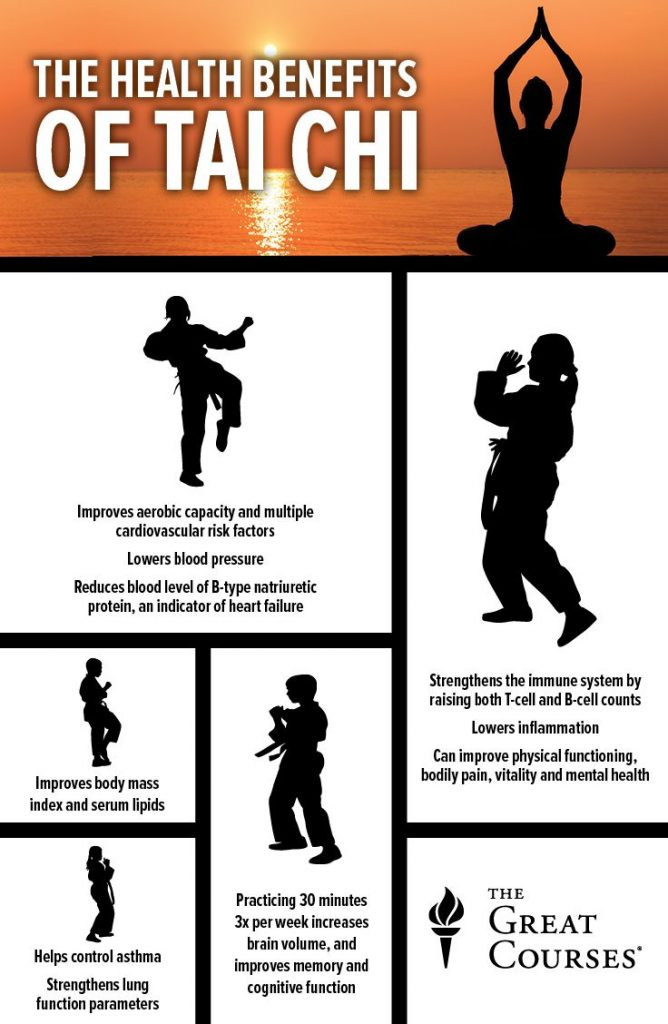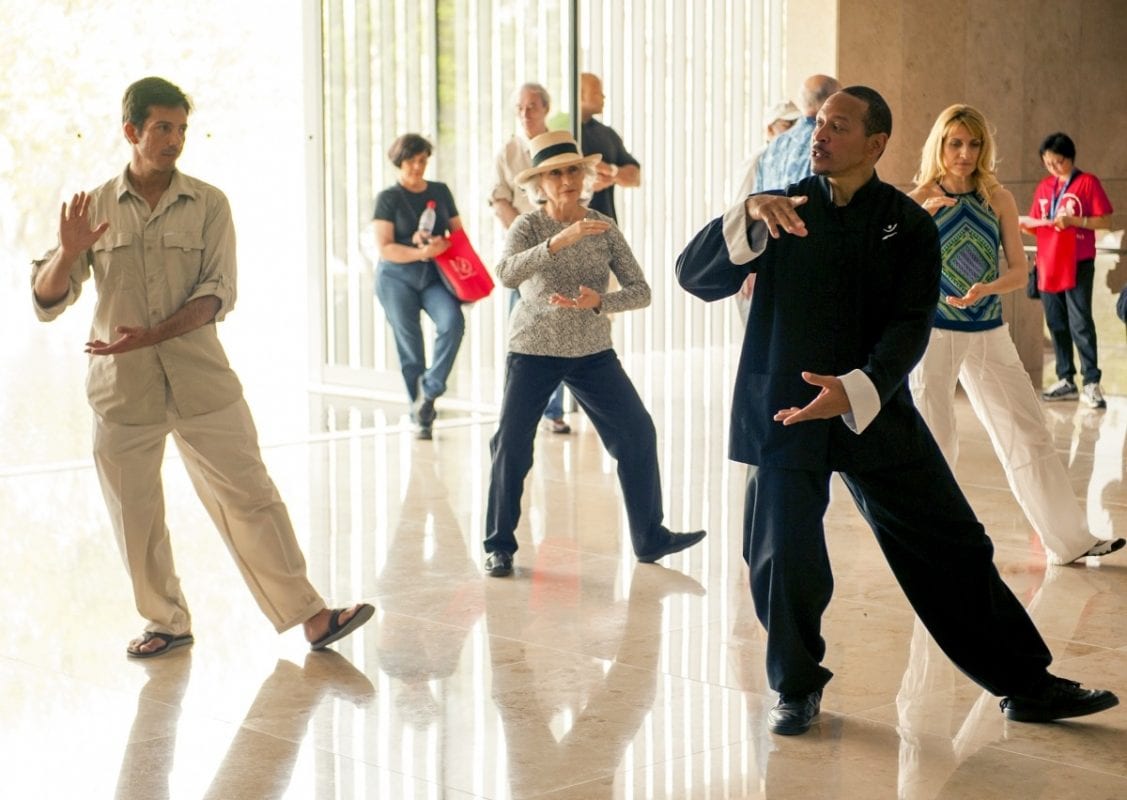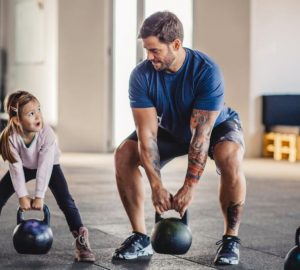Every morning you gaze upon a group of people performing slow movement exercise, and you instantly think karate. Well, yes it is a form of martial arts, but no, it’s not the type of martial arts that you see in movies. Tai Chi is an ancient Chinese form of martial arts that is popularly known for its beneficial health aspects. It is a complex form of martial arts that has evolved over time. Tai Chi combines all the slow and low-intensity movements of your body with proper breathing and meditation exercise. Despite what many people think, Tai Chi’s health benefits have been proved by numerous studies and researches. In fact, many professionals recommend Tai Chi for several health benefits, especially for older adults and for all anxiety related problems.
History of Tai Chi
Tai Chi is short for its original name of Tai Ji Quan or Tai Chi Chuan. Since its inception, it has been known for achieving “greater longevity” amongst ancient Chinese monks. Its origin is widely speculated, but the most agreed fact is that it came to existence before 700 years, although a large group of people also believe that it’s nearly 1500 years old. One common factor that everyone agrees on is the place of its origin: Chen village.
Its creation is mainly attributed to a Taoist Monk called Zhang San Feng. Tai chi or taiji in Chinese literature means “supreme ultimate,” and this is represented by combining “yin and yang” onto a single symbol. This translates to “supreme ultimate exercise.” It combines the breathing, movements, and visualization of the entire body simultaneously to promote a feeling of self-awareness. Taijichuan training technique mainly consists of 5 different elements: Taolu, qigong, neigong, tuishou, and Sanshou. But, the main element that Tai Chi uses is the “qigiong.” Qigong refers to the movement, breathing, meditation, and awareness exercise.

The Convenience and Simplicity of Tai Chi
Tai Chi as we know today is a blended form of exercise. The traditional and the original form of Tai Chi is combined with the natural movements using relaxation and breathing exercise to harness its optimal health benefits. The fact that Tai Chi involves slow and deliberate slow movements of the body along with proper meditation and breathing makes it convenient for any age group. It requires too little of the so-called “upper body strength” to perform Tai Chi. Hence, it has proven to be a very effective form of exercise for older people or sick people who cannot perform other stressful physical exercises.
There are numerous studies that showed that practicing Tai Chi reduces the chances of “falling” in older people. Apart from that, there have been other several studies that showed compelling evidence of the positive health benefits of Tai Chi.
What adds to the simplicity of Tai Chi is that it requires minimal strength and stress as well. It is an excellent form of exercise for beginners and older adults as well. The cost is also very minimal as compared to the cost of gym membership that most people pay.
The efficiency of Tai Chi
When it comes to Tai Chi or any other form of physical exercises that requires too little of physical stature, people automatically think Hokum. And it can be easily understood. After all, how can some bunch of people performing slow movement and breathing exercise claim to have such huge health benefits, right? Tai Chi literally involves some actions such as “white crane spreads its wings” or “box both ears” etc., so yes, to an outsider Tai Chi may seem like and look like an absurd and hilarious form of exercise. But, the simple fact is that Tai Chi has much stronger roots embedded and even mentioned in many ancient Chinese scripts. Every minor movement and every detail contributes to making Tai Chi one of the most efficient forms of exercises that are practiced today. Dr. Michael Irwin, a behavioral sciences professor at UCLA, the effectiveness of Tai Chi’s exercise technique lies in its “physical activity component.” The meditative and mindful quality of Tai Chi makes it such a compelling and effective technique.
In fact, a study conducted by the American Journal of Epidemiology concluded that practicing Tai Chi regularly has almost the same health benefits as jogging. The main health benefit have always been to prolong the lifespan or greater longevity. This study provided precise results to support this fact. Another article in PLOS One stated that Tai Chi was highly effective in promoting and improving the endurance, fitness and overall health of our heart and lungs.
Apart from promoting a longer lifespan and reducing the risks of falling in older people, some other proven Health Benefits of Tai Chi are –
Relieves stress
As mentioned above, Tai Chi is one of the most effective forms of exercises that many professionals recommend to their patients suffering from anxiety and depression related health issues. Its meditative and mindful aspect helps to promote a sense of calm and self-awareness amongst Tai Chi practitioners. A systematic review in 2014 performed on 2,553 adults showed significant positive results to support the stress relieving capability of Tai Chi.
Promotes weight loss
Although it’s a slow process, regular Tai Chi practitioners have experienced weight loss. A study was conducted in 2015 on a group of adult practicing for 45 minutes five times a week. The results at the end of the 12 weeks showed that they lost little over a pound of weight without any restrictions to their diet.
Better sleep
This is a very positive aspect of Tai Chi since the number of adults suffering from insomnia is very large in number. A pilot study conducted in 2016 on randomized controlled trials concluded with significant results to support the fact that Tai Chi improved the quality of sleep. The sleep qualities involved were longer sleep duration and sleep efficiency in terms of how quickly they found sleep.
Is Tai Chi Safe?
Tai Chi in its primary form is one of the safest forms of exercises. This is primarily because it requires so little of physical stress. There are some minimal side-effects such as experiencing minor pains or aches, especially for beginners. But, there are no long-term side effects of practicing. For pregnant women, it is best to take professional advice before practicing Tai Chi.
How to get started?
Tai Chi composes of several movements and minute breathing exercise. It may look simple, but in reality, Tai Chi is of complete adverse nature than its outer looks. It is best if you can get a personal instructor or contact Tai Chi For Health Institute that can help you harness the optimum health benefits of practice.
Tai Chi is a graceful form of exercise that combines gentle movements and deep breathing to promote relaxation, balance, and overall well-being. Here are some beginner-friendly movements along with simple instructions:
Wuji Stance:
- Stand with your feet shoulder-width apart.
- Relax your shoulders, keep your back straight, and slightly bend your knees.
- Place your hands by your sides, palms facing inward.
- Focus on your breath, taking slow and deep breaths.
Tai Chi Walk:
- Start in the Wuji stance.
- Take a small step forward with your left foot.
- Transfer your weight forward and follow with your right foot.
- Repeat this smooth, walking motion, maintaining a steady pace.
Cloud Hands:
- Begin with feet shoulder-width apart, knees slightly bent.
- Raise both arms to chest level, palms facing each other.
- Rotate your torso to the right, shifting weight to the right leg.
- Move your left hand down and right hand up, creating a flowing, circular motion.
- Reverse the movement to the left side, creating a continuous, cloud-like motion.
Wave Hands Like Clouds:
- Start in a relaxed stance with arms at your sides.
- Begin a circular motion with your left arm, bringing it up and across your body.
- As the left hand descends, the right hand follows in a flowing, wave-like pattern.
- Coordinate the movement with weight shifts between your feet.
Single Whip:
- Begin with feet shoulder-width apart.
- Shift weight to your right leg, and turn your body to the right.
- Extend your left hand forward with fingers pointing down, and the right hand rests on the side.
- Keep your spine straight and engage your core.
Golden Rooster Stands on One Leg:
- Start in the Wuji stance.
- Shift weight to your left leg and raise your right knee in front of you.
- Hold your right foot with your right hand, balancing on one leg.
- Repeat on the other side.
Tai Chi Ball:
- Hold an imaginary ball in front of your chest with both hands.
- Rotate the ball to the right and shift your weight to the right foot.
- Rotate the ball to the left and shift your weight to the left foot.
- Continue this gentle, circular motion.
Remember, when practicing Tai Chi, focus on slow, controlled movements, and maintain a relaxed state. Breath deeply and naturally, and gradually increase the duration and complexity of your movements as you become more comfortable with the practice. If possible, consider taking a class or watching instructional videos for a more thorough understanding of the techniques.








